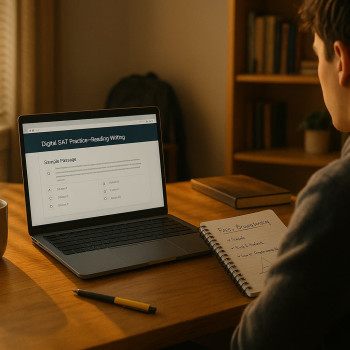AP vs SAT: Preparing When Your Wi Fi Fades A Practical Guide for Students and Parents
Picture this: you re two weeks from a big AP exam or the Digital SAT, your neighborhood s internet is spotty, and the cozy corner of the local library is too far for daily trips. Panic? Not necessary. With thoughtful planning, tested low bandwidth techniques, and a few offline tricks, you can still ace your prep. This article walks you and your family through realistic, calm, and effective strategies to study for AP courses and the Digital SAT without relying on high speed internet.

Why plan for low bandwidth or offline study?
Not every student has reliable high speed internet at home. Even when connections exist, exams and deadlines don’t wait for outages. Planning ahead means:
- Keeping momentum when connectivity drops.
- Reducing last minute stress and cram sessions that depend on streaming videos or online simulations.
- Creating sustainable study habits that work anywhere: at home, in the car, or sitting at a kitchen table.
Understand the tests so your offline plan fits the purpose
AP Exams What matters (and what you can practice offline)
AP courses are college level classes in specific subjects, and most AP exams assess course knowledge in May. Many AP subjects now have digital elements or use hybrid delivery, but the core of preparation is the same: content mastery, timed practice, and skills like analysis, synthesis, and clear writing. Offline activities that help include practice essays, past free response questions you print, problem sets, vocabulary lists, and handwritten practice.
Digital SAT What to focus on without streaming
The Digital SAT emphasizes clear reading, math problem solving, and timing strategy. While the test is delivered on a digital platform, the bedrock skills reading comprehension, algebra and data analysis, and logical reasoning can be practiced offline. Paper practice, printed practice tests, and timed drills still mirror real test demands and help build stamina.
Core principles for low bandwidth/offline prep
These principles guide everything else below. Keep them visible on your fridge or planner:
- Prioritize fundamentals over bells and whistles. Strong reading and math foundations beat one more online video.
- Simulate test conditions regularly using printed or handwritten materials.
- Turn passive consumption into active practice handwriting answers, speaking aloud, and teaching back are powerful.
- Use brief, focused sessions (25 50 minutes) to maximize retention without needing long videos.
- Back up your digital purchases or downloads to local storage so you can access them offline.
Practical offline tools and resources you can assemble today
Here are things you can collect and organize now, with minimal internet time:
Printable and physical materials
- Official practice question PDFs for AP course free response and multiple choice. Print sets of past free response questions and scoring rubrics to practice under timed conditions.
- Paper SAT practice tests and math problem sets printed in booklets. Fold pages into a test booklet and time yourself with a simple stopwatch or phone timer (download the app ahead of time).
- Subject notebooks: a single composition notebook for each AP subject and one for SAT strategy. Use them for error logs, vocabulary, formula sheets, and quick concept maps.
- Flashcards (index cards or paper cut outs) for vocabulary, formulas, and quick facts perfect for bus rides or waiting rooms.
Low tech digital prep (download once, use offline)
- Download important PDFs, practice exams, and sample essays while you have connection and save them to your device or a USB drive.
- Save short video lessons locally (if the terms allow) or transcribe key points into note cards.
- Export your study schedule as a printable calendar and pin it up where you’ll see it daily.
Study schedules that work offline
Structure matters more than perfection. Below are two sample schedules you can adapt: a focused one month ramp and a long game three month plan. Both emphasize paper practice and timed drills.
One Month Intensive Schedule (for students 2 4 weeks from test day)
- Daily: 90 120 minutes split into two or three blocks.
- Block 1 (45 60 minutes): Warmup vocabulary/formula review + targeted concept practice.
- Block 2 (45 60 minutes): Timed practice section (AP multiple choice / SAT reading or math) or one AP free response essay under timed conditions.
- Weekly: Full practice test (rotate AP subject sections or a full SAT practice test) in simulated conditions.
- Weekly review: One hour with parents or a study partner to go over errors and adjust the plan.
Three Month Sustainable Schedule (for students building mastery)
- Daily: 60 90 minutes, three days on content, two days on practice, one rest/light review day, one catch up day.
- Every other week: One full length practice test (SAT) or two complete AP practice sections with handwritten free responses.
- Monthly: A deeper checkpoint review error logs, update your weakest topics, and set new micro goals.
How to create a high impact offline practice session
Every session should have a clear objective. Use this 4 step routine:
- Set a specific goal (e.g., “Complete and score one AP Biology free response question focusing on experimental design”).
- Warm up for 5 10 minutes with flashcards or a quick review of your error log.
- Complete a timed practice task on paper (or in a printed booklet).
- Score, analyze, and log errors in your notebook. Write one targeted action for next time.
Example: 60 minute AP English session
- 10 min Literary terms flashcards and margin notes review.
- 35 min Write a free response essay from a printed prompt under timed conditions.
- 15 min Self score using the rubric and note two specific changes to make next time.
Using error logs and active recall (no internet needed)
An error log is the most powerful offline tool you ll use. Each time you make a mistake on a practice question, write:
- The question topic (e.g., linear equations, rhetorical devices).
- Why you missed it (content gap, careless error, timing).
- A corrective action (e.g., review notes, drill 10 similar problems, memorize formula).
Review your error log weekly actively try to explain each mistake out loud as if teaching someone. Teaching is retention gold and completely offline.
Creating realistic test simulations for AP and SAT
Replicating exam conditions builds confidence and reduces test day surprises. For digital SAT awareness: the delivery is on a device, but you can still replicate timing, pacing, and question types using printed sections.
How to simulate a digital SAT session on paper
- Print the same number of questions for each section as the digital test provides and create a test booklet.
- Use a timer and strictly enforce section timing and breaks.
- Answer on paper, then transfer your answers to a single answer sheet for scoring. This trains you to avoid tracking errors and improves speed.
Small tech investments that pay big offline dividends
Some affordable, low maintenance tech can help without needing continuous internet:
- A basic tablet or laptop with ample storage download practice PDFs and video lessons for offline viewing.
- A portable battery pack and a simple calculator approved for tests that require one. Keep a spare set of batteries for allowed calculators.
- A USB drive with organized folders of practice tests, rubrics, and cheat sheets.
Study strategies by subject (AP subjects and SAT focus areas)
AP Science and Math
Practice problem sets, lab notebook summaries, and past free response questions are your friends. For lab based courses, handwriting experiment summaries and sketching data visualizations trains you for applied questions.
AP Humanities and Languages
Write practice essays by hand, annotate printed passages, and read primary texts in print. Use vocal practice to rehearse thesis statements and transitions oral fluency improves written clarity.
SAT Reading and Writing
Print reading passages, underline and annotate, and summarize each paragraph in the margins. For writing, edit printed paragraphs to practice concision and grammar.
SAT Math
Work problems by hand, show all work, and time yourself on sets of 10 15 questions. Build a small formula/reference sheet you memorize so you don’t hunt for formulas during the test.
How parents can support offline study without micromanaging
Parents, your role is crucial: provide structure, encouragement, and practical support. You don’t need subject expertise to help:
- Help set up a quiet, consistent study space and keep supplies stocked: paper, pens, a timer, and printed practice tests.
- Be the accountability partner check the weekly schedule, help enforce test simulations, and celebrate small wins.
- Encourage healthy habits: sleep, hydration, and short physical activity breaks. Cognitive performance is strongly tied to rest and nutrition.
When to bring in personalized help and how Sparkl can fit naturally
Sometimes a student needs more targeted guidance: confusing concepts, recurring errors, or trouble converting offline practice into score gains. That s where one on one support helps. Personalized tutoring, like Sparkl s offerings, can integrate seamlessly into a low bandwidth plan: tutors can provide tailored study plans that you can print, suggest prioritized printable practice, and supply AI driven insights about weaker areas to focus on offline. Small, periodic tutor sessions even if delivered over a phone call or during brief connected periods can unlock large improvements by making offline study more efficient and less guesswork driven.
Table: Quick comparison Offline study focus for AP vs Digital SAT
| Feature | AP Exams (Offline Focus) | Digital SAT (Offline Focus) |
|---|---|---|
| Primary Materials | Printed course CEDs, past FRQs, rubric printouts, lab notebooks | Printed practice sections, math workbooks, reading passage packets |
| Core Skills to Practice | Deep content knowledge, experimental reasoning, essay structure | Timed problem solving, passage annotation, pacing strategies |
| Simulation Strategy | Timed FRQ essays, full subject sections under quiet conditions | Sectioned timed drills, answer sheet transfer to simulate device timing |
| Assessment | Self score with rubric; error logs; peer review for essays | Self score; time logs; targeted topical drills |
| Best Offline Tools | Notebooks, flashcards, lab summaries, printed sample responses | Practice booklets, formula sheets, error logs, timed drills |
Low bandwidth routine examples you can start tonight
Try these short routines that require nothing more than paper and a timer.
15 minute daily rhythm
- 3 minutes Review two flashcards (vocab or formulas).
- 10 minutes One focused question, hand solve and mark errors.
- 2 minutes Add a note to your error log or plan next step.
50 minute deep block
- 10 minutes Warmup and formula/vocab review.
- 30 minutes Timed section or a free response prompt under test conditions.
- 10 minutes Score, analyze, and write one targeted action.
Dealing with anxiety and staying motivated offline
Offline study can feel isolating here s how to keep momentum:
- Mix in short group sessions with classmates (in person or scheduled phone calls) to review a tough concept.
- Set micro rewards for milestones: a favorite snack after a full practice test or a family movie night after two weeks of consistent study.
- Use positive, specific affirmations: instead of I can t do this, try I ll solve three practice problems today and review mistakes.
Final checklist: Before your next offline study week
- Print or collect all practice materials you ll need for the week.
- Create a simple measurable goal for each day and add it to a visible calendar.
- Charge devices, copy files to a USB, and place a small stack of index cards nearby.
- Schedule one checkpoint with a tutor or teacher, and optionally share your error log for targeted feedback a single 30 minute session can change your plan smartly.

Parting thought: Small systems beat last minute miracles
When internet is limited, preparation doesn’t stop it adapts. A steady routine built around printed practice, timed simulations, error logging, and targeted review will move the needle more reliably than one more passive video watched the night before. And when you do decide to bring in extra help, personalized tutoring like Sparkl fits naturally into this framework by turning offline habits into measurable gains: tailored study plans you can print, targeted priorities to address your error log, and expert coaches who guide your practice without demanding high bandwidth.
Start small, stay consistent, and remember: progress in test prep is a series of tiny, intentional improvements. Offline or online, those improvements add up to real results.
Ready to make your offline plan?
Take five minutes tonight: print one practice section, write down three clear study goals for the week, and schedule one simulated test. You ll thank yourself when the lights flicker and your prep keeps going strong.




















No Comments
Leave a comment Cancel